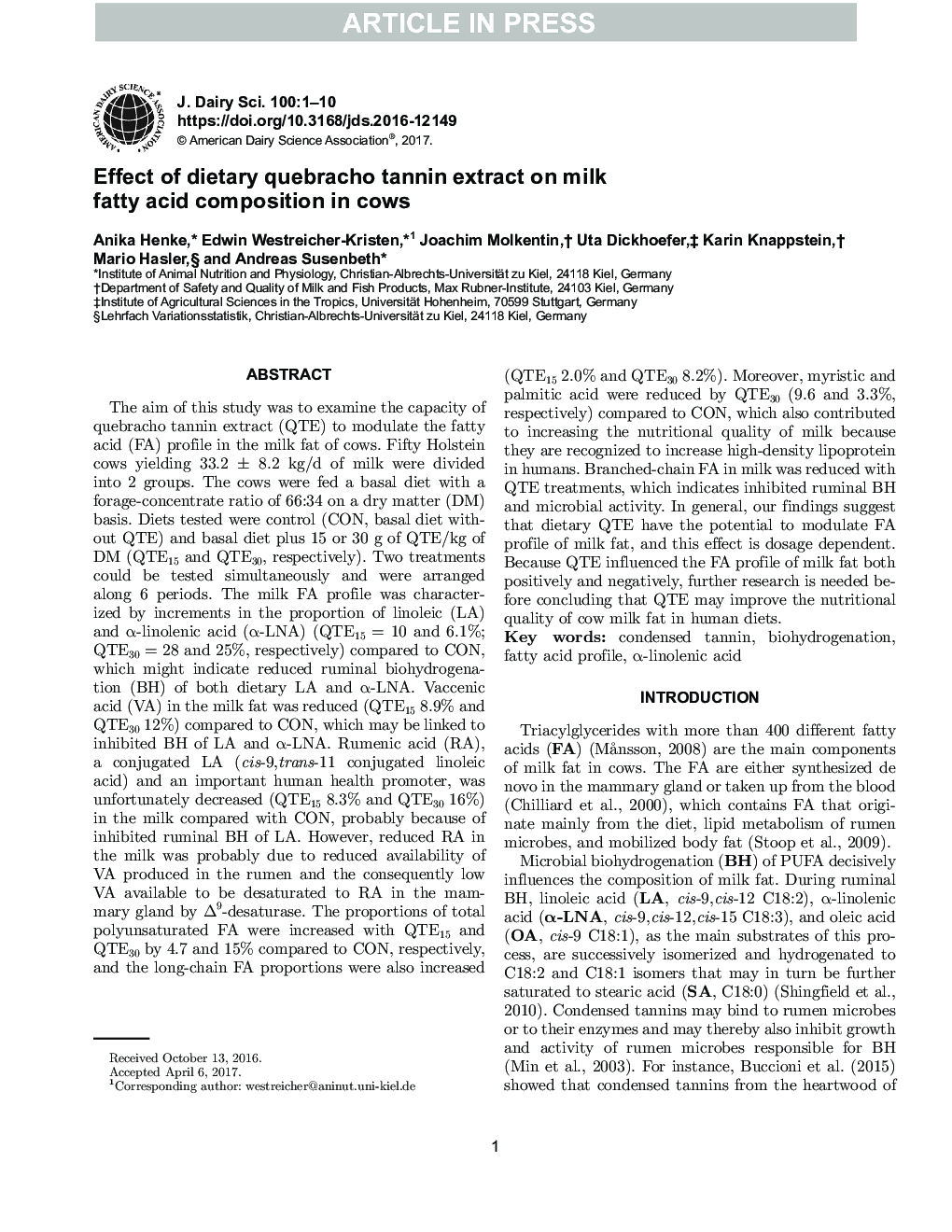| کد مقاله | کد نشریه | سال انتشار | مقاله انگلیسی | نسخه تمام متن |
|---|---|---|---|---|
| 5541904 | 1402512 | 2017 | 10 صفحه PDF | دانلود رایگان |
عنوان انگلیسی مقاله ISI
Effect of dietary quebracho tannin extract on milk fatty acid composition in cows
ترجمه فارسی عنوان
اثر عصاره کایابی چای تانین بر ترکیبات اسید چرب شیر در گاوها
دانلود مقاله + سفارش ترجمه
دانلود مقاله ISI انگلیسی
رایگان برای ایرانیان
کلمات کلیدی
تانن متراکم شده، بیو هیدروژناسیون، مشخصات اسید چرب، اسید ¬-لینولنیک،
موضوعات مرتبط
علوم زیستی و بیوفناوری
علوم کشاورزی و بیولوژیک
علوم دامی و جانورشناسی
چکیده انگلیسی
The aim of this study was to examine the capacity of quebracho tannin extract (QTE) to modulate the fatty acid (FA) profile in the milk fat of cows. Fifty Holstein cows yielding 33.2 ± 8.2 kg/d of milk were divided into 2 groups. The cows were fed a basal diet with a forage-concentrate ratio of 66:34 on a dry matter (DM) basis. Diets tested were control (CON, basal diet without QTE) and basal diet plus 15 or 30 g of QTE/kg of DM (QTE15 and QTE30, respectively). Two treatments could be tested simultaneously and were arranged along 6 periods. The milk FA profile was characterized by increments in the proportion of linoleic (LA) and α-linolenic acid (α-LNA) (QTE15 = 10 and 6.1%; QTE30 = 28 and 25%, respectively) compared to CON, which might indicate reduced ruminal biohydrogenation (BH) of both dietary LA and α-LNA. Vaccenic acid (VA) in the milk fat was reduced (QTE15 8.9% and QTE30 12%) compared to CON, which may be linked to inhibited BH of LA and α-LNA. Rumenic acid (RA), a conjugated LA (cis-9,trans-11 conjugated linoleic acid) and an important human health promoter, was unfortunately decreased (QTE15 8.3% and QTE30 16%) in the milk compared with CON, probably because of inhibited ruminal BH of LA. However, reduced RA in the milk was probably due to reduced availability of VA produced in the rumen and the consequently low VA available to be desaturated to RA in the mammary gland by Î9-desaturase. The proportions of total polyunsaturated FA were increased with QTE15 and QTE30 by 4.7 and 15% compared to CON, respectively, and the long-chain FA proportions were also increased (QTE15 2.0% and QTE30 8.2%). Moreover, myristic and palmitic acid were reduced by QTE30 (9.6 and 3.3%, respectively) compared to CON, which also contributed to increasing the nutritional quality of milk because they are recognized to increase high-density lipoprotein in humans. Branched-chain FA in milk was reduced with QTE treatments, which indicates inhibited ruminal BH and microbial activity. In general, our findings suggest that dietary QTE have the potential to modulate FA profile of milk fat, and this effect is dosage dependent. Because QTE influenced the FA profile of milk fat both positively and negatively, further research is needed before concluding that QTE may improve the nutritional quality of cow milk fat in human diets.
ناشر
Database: Elsevier - ScienceDirect (ساینس دایرکت)
Journal: Journal of Dairy Science - Volume 100, Issue 8, August 2017, Pages 6229-6238
Journal: Journal of Dairy Science - Volume 100, Issue 8, August 2017, Pages 6229-6238
نویسندگان
Anika Henke, Edwin Westreicher-Kristen, Joachim Molkentin, Uta Dickhoefer, Karin Knappstein, Mario Hasler, Andreas Susenbeth,
